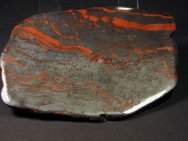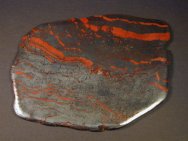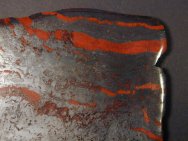|  This
banded iron testament to the rusting of the earth in the Lower
Proterozoic is classic and dense, with high content of magnetite
(Fe3O4), a natural magnet. The pictures speak adequately to its
inherent beauty. The color changes dramatically with angle of
incident light from black to metallic silver (compare the pictures).
Note the various size streaks of red rusted sediment. This
banded iron testament to the rusting of the earth in the Lower
Proterozoic is classic and dense, with high content of magnetite
(Fe3O4), a natural magnet. The pictures speak adequately to its
inherent beauty. The color changes dramatically with angle of
incident light from black to metallic silver (compare the pictures).
Note the various size streaks of red rusted sediment.
This
rock resulted from accumulations of ferrous Iron (Fe+2) in aquatic
and marine environments. The iron readily combined with the  microorganism-produced
and increasingly abundant oxygen to produce Fe2O3 iron precipitates,
thus removing it from the atmosphere. Extensive banded iron formations
(BIF) were laid down during the Proterozoic, while sedimentary
rock formations such as shale, sandstone, and carbonates (i.e.,
limestone) were far less prevalent. By the early proterozoic some
2.3 billion years ago, oxygen levels has risen sufficiently to
enable the formation of ferric oxides (Hematite) that made prominent
so-called red beds. microorganism-produced
and increasingly abundant oxygen to produce Fe2O3 iron precipitates,
thus removing it from the atmosphere. Extensive banded iron formations
(BIF) were laid down during the Proterozoic, while sedimentary
rock formations such as shale, sandstone, and carbonates (i.e.,
limestone) were far less prevalent. By the early proterozoic some
2.3 billion years ago, oxygen levels has risen sufficiently to
enable the formation of ferric oxides (Hematite) that made prominent
so-called red beds.
The specimen has been hand-polished to a glassine
finish on one side with fine carbide and diamond abrasive, a very
labor-intensive job.
| 






